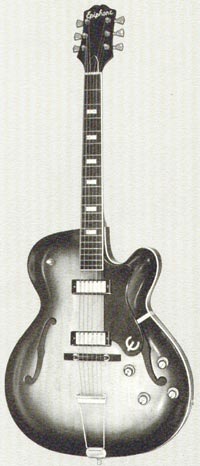
 Early 1960s Gibson-made Epiphone Zephyr
Early 1960s Gibson-made Epiphone ZephyrThere were several earlier Epiphone instruments using the name Zephyr, dating back to the 1930s, including the Zephyr De Luxe, Zephyr De Luxe Regent, Zephyr Regent as well as Zephyr Spanish guitar, Zephyr mandolin, Zephyr Hawaiian guitar and a Zephyr amplifier. At one point the name Zephyr signified the instrument as being electric rather than acoustic, and the name Regent signified a body cutaway.
The Zephyr guitars had the same large 17 3/8" x 20 3/4" body size, but differed to some extent in terms of appointments (inlays etc), hardware and cutaway. The 1950 catalogue shows several models, with one or two pickups, and frequensator or trapeze tailpieces. By the mid 1950s, however, the only guitar using the name was the Zephyr Electric, model E311/E312 (Blonde/Shaded finish), which most closely resembled the 1950 Zephyr Regent regular, with it's body cutaway, single pickup and a trapeze tailpiece.
“A single adjustable pickup, governed by a single tone control, gives the player an amazing choice of voice - from round, velvet-like tone to dominating brilliance. The advantage of a single pickup is it's great frequency response from both bass and treble strings.”
Gibson went on to acquire Epiphone, it's tooling and numerous unfinished guitars and components in 1957. Numerous Epiphone models were offered, and the Zephyr was one of them, first shipping from Kalamazoo in 1959. Early Kalamazoo-made models used older Epiphone parts: New York pickups, and the classic metal Epiphone headstock logo, looking somewhat like the previous Zephyr Electric, but with two pickups. The body size remained unchanged, as did the model designation E312, although tweaked to E312T to underline the thinline body style.
Gibson did, however, make some revisions, fitting two pickups like some of the the earlier versions, but providing a separate tone and volume control for each pickup - for the first time. Production was relatively short; most US-built Epiphones were produced through to 1969, the Zephyr was only shipped for five years 1959-63. In total 415 guitars were shipped - over 85% of them in Epiphone's Shaded (Sunburst) finish.
Shipping figures are not available for the Stathopoulos-era (pre-Gibson) Epiphones, however they are for the Gibson Kalamazoo period. As can be seen, in 1959, the original Epiphone model number for the Blonde Zephyr (E311) is used in addition to the 'T' and 'N' suffixes typically used by Gibson. Beyond this time, both finish options were given model designation E312T or E312TN.
| 1959 | 1960 | 1961 | 1962 | 1963 | total | |
| E311TN | 8 | 8 | ||||
| E312TN | 17 | 13 | 11 | 13 | 54 | |
| E312T | 137 | 106 | 46 | 21 | 43 | 353 |
| total | 145 | 123 | 59 | 32 | 56 | 415 |
$7500
$1495
$750
$1200
$2950
$1350
$8695
$1600
$803
$1800
$3600
$3199
$3560
$1475
$4495
$4400
€1186
£670
£1099
€49